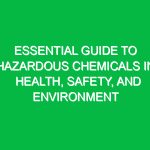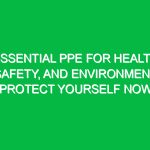Introduction
Hello, team! Today, we’re gathering for a Toolbox Talk focused on Work Area Best Practices. Our goal is to ensure that everyone understands how to maintain a safe and efficient work Environment. This talk is crucial in the context of Health, Safety, and Environment (HSE) as it directly impacts our daily operations and overall Safety culture.
By implementing Best Practices in our work areas, we can reduce the risk of accidents, enhance productivity, and create a healthier workplace. Let’s dive into the key aspects of these practices and how they can benefit us all.
Understanding Work Area Best Practices
So, what exactly do we mean by Work Area Best Practices? Essentially, these are guidelines and Procedures designed to optimize Safety, efficiency, and organization in our workspaces. They encompass everything from proper equipment usage to maintaining cleanliness and managing Hazards.
To make this practical, let’s break it down into key components. We’ll discuss:
- Organizational principles
- Hazard identification and mitigation
- Emergency preparedness
- Regular Maintenance and inspections
- Training and communication
Organizational Principles
One of the foremost Work Area Best Practices is keeping our workspaces organized. An organized area not only enhances productivity but also minimizes the risk of accidents. Here are some tips to achieve this:
- Keep walkways clear: Ensure that pathways are free from obstructions. This is crucial, especially in emergency situations where quick exits may be necessary.
- Label everything: Clearly label equipment, storage areas, and hazardous materials. This helps everyone know where things belong and reduces confusion.
- Use storage solutions: Invest in shelving, bins, and other storage solutions to keep tools and equipment organized. This not only saves time but also prevents accidents.
For example, think about a scenario where a tool is misplaced. In a cluttered environment, an employee might spend unnecessary time searching for it, leading to frustration and potential safety risks. By maintaining an organized workspace, we can avoid such situations.
Hazard Identification and Mitigation
Identifying and mitigating Hazards is a crucial aspect of Work Area Best Practices. Every work area has its unique risks, and it’s vital to be aware of them to prevent accidents.
Start by conducting regular risk assessments to identify potential hazards. Here are some common hazards to look for:
- Slips, trips, and falls: These can occur due to wet floors, uneven surfaces, or clutter.
- Electrical Hazards: Exposed wires or overloaded circuits can pose significant risks.
- Ergonomic risks: Poor workstation setup can lead to musculoskeletal disorders.
Once hazards are identified, it’s essential to put mitigation strategies in place. This might include:
- Implementing proper signage
- Using Personal Protective Equipment (PPE)
- Providing Training on Safe Practices
For instance, if we identify that a certain area tends to be slippery, we can place warning signs and ensure that the area is cleaned regularly to prevent accidents.
Emergency Preparedness
Another critical component of Work Area Best Practices is emergency preparedness. Regardless of how proactive we are about safety, emergencies can still happen. Therefore, we must be ready.
Start by ensuring that all employees are familiar with emergency exits, evacuation routes, and assembly points. Conduct regular drills to reinforce this knowledge. Additionally, consider the following:
- Keep emergency equipment accessible: Fire extinguishers, first aid kits, and eye wash stations should be easily reachable.
- Develop an emergency response plan: This plan should outline procedures for various emergencies, including fire, chemical spills, and medical emergencies.
- Communicate effectively: Ensure everyone knows how to report an emergency and who to contact.
For example, during a fire drill, everyone should know where to go and what to do. Practicing this will help ensure a calm and efficient response in a real emergency.
Regular Maintenance and Inspections
Maintenance plays a vital role in Work Area Best Practices. Regular inspections and maintenance of equipment and workspaces can prevent hazards and promote a safe environment.
Here are a few steps to incorporate:
- Schedule regular inspections: Conduct routine checks on equipment, tools, and the workspace itself.
- Document findings: Keep records of inspections and maintenance activities. This helps track issues and ensures accountability.
- Address issues promptly: If a hazard is identified during an inspection, take immediate action to rectify it.
For instance, if a piece of machinery is found to be malfunctioning, it should be taken out of service until repairs are made. This proactive approach can save lives and reduce downtime.
Training and Communication
Effective training and communication are essential in implementing Work Area Best Practices. Everyone should understand safety protocols and procedures to foster a culture of safety.
Consider these training practices:
- Conduct regular safety meetings: Hold Toolbox Talks like this one to discuss safety topics and share experiences.
- Provide hands-on training: Ensure employees know how to use equipment safely and understand procedures.
- Encourage open communication: Create an environment where employees feel comfortable reporting hazards or unsafe conditions.
For example, during a Toolbox Talk, we can share experiences related to hazards encountered in the workplace. This not only raises awareness but also promotes a collaborative approach to safety.
Real-Life Examples and Scenarios
Let’s take a moment to discuss real-life scenarios to illustrate these Work Area Best Practices. Imagine a situation where an employee is using a power tool without proper Personal Protective Equipment. This not only puts the individual at risk but also sets a poor example for others.
Conversely, consider a scenario where employees regularly wear their Safety Gear, follow organizational principles, and report hazards promptly. This proactive attitude fosters a safer work environment and minimizes risks.
By sharing these examples, we highlight the importance of adherence to best practices in our daily operations. It can be the difference between a safe day at work and an accident that could have been prevented.
Key Regulations and Standards
It’s essential to understand the regulations and standards that guide our Work Area Best Practices. Compliance with Occupational Safety and Health Administration (OSHA) regulations, for example, helps ensure that we are meeting safety standards and legal obligations.
Being aware of these regulations not only protects us but also reinforces our commitment to a safe workplace. Failure to comply can lead to serious consequences, including fines and increased risk of accidents.
Conclusion
As we wrap up this Toolbox Talk, let’s summarize the key points we’ve discussed today:
- Maintain organization in work areas
- Identify and mitigate hazards
- Prepare for emergencies
- Conduct regular maintenance and inspections
- Prioritize training and communication
By applying these Work Area Best Practices, we can foster a safer and more efficient work environment. Remember, safety is a collective responsibility, and each of us plays a vital role in maintaining it.
Thank you all for your attention and commitment to safety. Let’s keep these practices in mind as we move forward in our daily tasks. Do you have any questions or thoughts you’d like to share?


